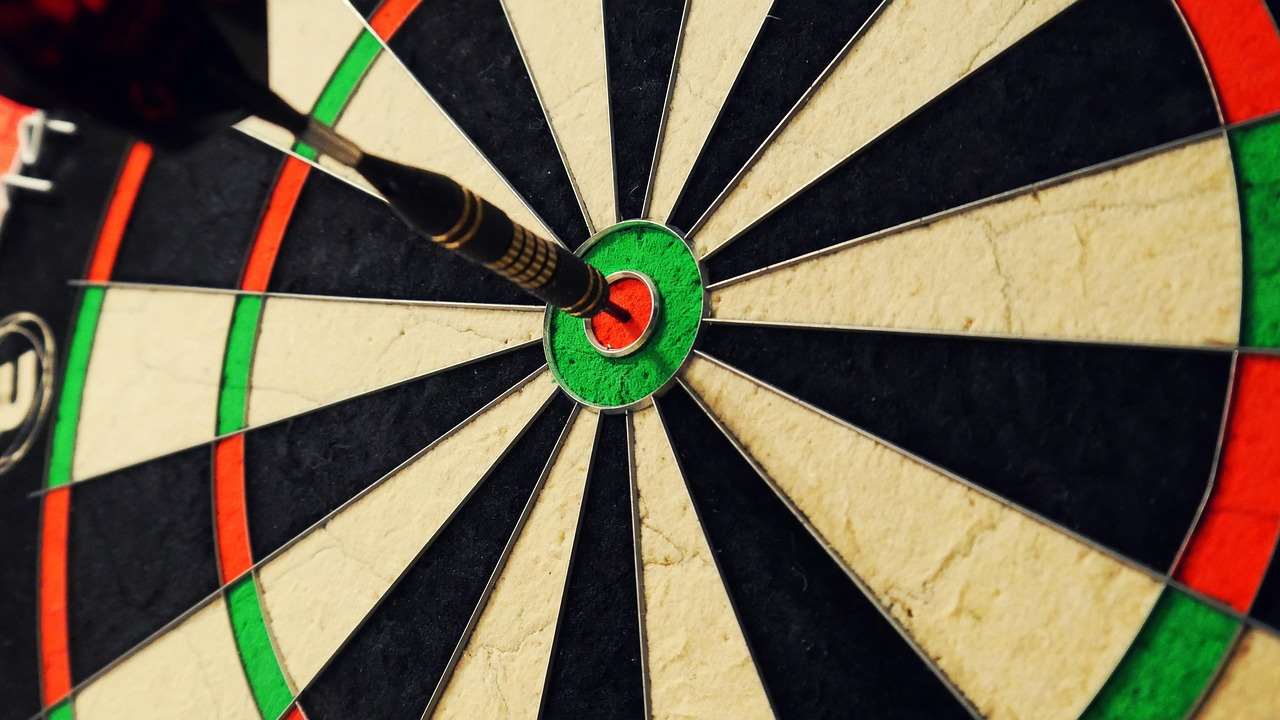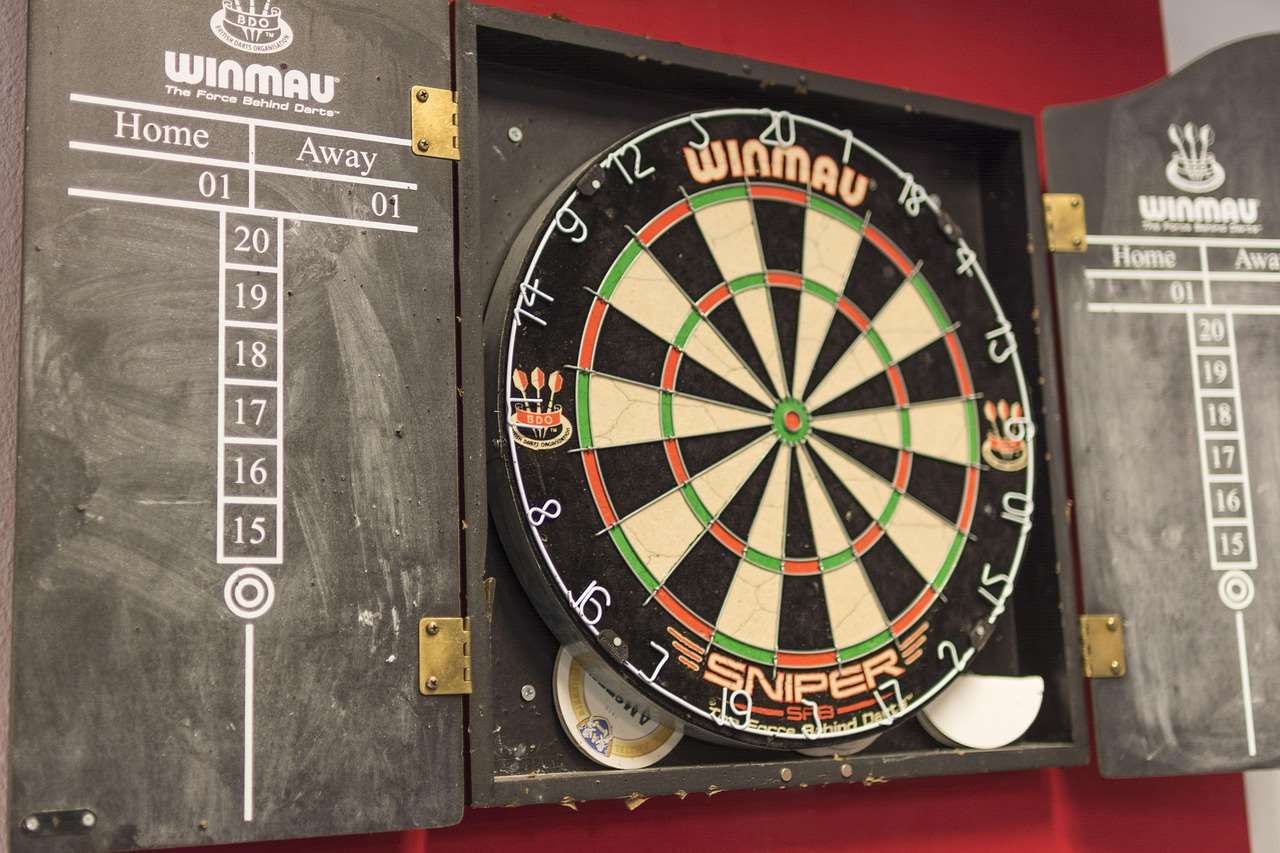Mastering the correct darts scoring procedure is crucial for enjoying fair and competitive games. This guide breaks down everything you need to know, from basic scorekeeping to handling common scoring challenges and understanding different game variations.
⚠️ Still Using Pen & Paper (or a Chalkboard)?! ⚠️
Step into the future! The Dart Counter App handles all the scoring, suggests checkouts, and tracks your stats automatically. It's easier than you think!
Try the Smart Dart Counter App FREE!Ready for an upgrade? Click above!
Understanding the Basics of Darts Scoring
At its heart, darts scoring is simple: each dart scores the value of the segment it lands in. However, complexities arise with doubles, trebles, and the bullseye. Before diving into the nuances, it’s essential to grasp the fundamental scoring zones. Each section of the dartboard corresponds to a numerical value, ranging from 1 to 20. Hitting a dart in one of these sections awards you that number of points.
The outer ring is the **double ring**, and landing a dart there doubles the score of that section. The inner ring is the **treble ring**, tripling the section’s score. The bullseye comprises two sections: the outer bull (often called the single bull) which scores 25 points, and the inner bull (or double bull) which scores 50 points. Understanding these basic elements is vital for accurate scoring and strategic gameplay. For more information on Basic Darts Fundamentals for Beginners, check out our comprehensive guide.
Step-by-Step Guide to Correct Darts Scoring Procedure
Following a structured approach is key to maintaining an accurate score. This includes properly marking the scores and verifying them after each player’s turn. Here’s a detailed breakdown:
- Nominate a Scorer: Designate one person to keep track of the scores. This role requires attention to detail and impartiality.
- Starting Score: Begin with the agreed-upon starting score, typically 501 or 301.
- Dart Values: After each dart is thrown, announce the value scored. For example, “Treble 20,” “Double 16,” or simply “19.”
- Calculating the Remaining Score: The scorer subtracts the total value of the three darts from the player’s current score. Announce the new remaining score clearly.
- Marking the Score: Record the scores accurately, using a whiteboard, scorecard, or digital app. Ensure clear and legible notation.
- Verification: After each turn, both players should verify the calculated score to minimize errors.
- Busting: If a player scores more points than needed to reach zero, leaving them with a negative score or a score of 1, it’s considered a “bust,” and their score reverts to what it was at the start of that turn.
- Winning: The game is won when a player reaches exactly zero by hitting a double.

It is useful to utilise online resources and darts scoreboards to keep track of games. These resources can sometimes calculate the best way to check out a remaining total too.
Essential Darts Scoring Terms
Familiarizing yourself with common darts terminology can greatly improve your understanding and communication during games. Key terms include:
- Checkout: The final throw that reduces the score to exactly zero, finishing on a double.
- Bust: An invalid throw that results in a score of one or less, or exceeds the required score to reach zero.
- Ton: A score of 100 or more in a single turn.
- Ton 80 (180): The highest possible score in a single turn, achieved by hitting three treble 20s.
- Leg: A single game of darts, typically starting from 501 or 301.
- Set: A group of legs played, often in a best-of format.
Common Scoring Errors and How to Avoid Them
Even experienced players occasionally make mistakes. Recognizing common errors and implementing preventive measures can ensure accurate scoring. Some common errors include miscalculating subtraction, misreading dart positions (especially near the wires), and forgetting to verify scores after each turn. To minimize these errors:
- Double-Check Calculations: Take your time when subtracting and verifying scores.
- Clear Communication: Clearly announce each dart’s value and the resulting score.
- Dart Placement: Carefully observe the dart’s position in relation to the board segments.
- Utilize Scoring Apps: Consider using a darts scoring app to automate calculations and track scores.
Accurate scoring is the backbone of fair play in darts. By following the correct darts scoring procedure, players can avoid disputes and ensure that games are conducted in a spirit of sportsmanship and precision.

Advanced Darts Scoring Techniques and Strategies
Beyond the basics, strategic scoring can significantly enhance your gameplay. This involves aiming for specific targets to set up future checkouts and maximizing your scoring potential. Some advanced techniques include:
- Checkout Planning: Strategically reduce your score to leave yourself with a manageable double for the final dart.
- High Scoring Aims: Aim for treble 20 (T20) whenever possible to maximize points per turn.
- Switching Targets: If T20 is blocked, switch to T19 for consistent scoring.
Developing a checkout chart or learning common checkout combinations can significantly improve your strategic play. Understanding which numbers leave you with easy doubles can be the difference between winning and losing. For example, knowing that 32 is double 16, or 40 is double 20, and planning accordingly can be very effective. You may also be interested in Fun dart game variations with modified rules.
Correct Darts Scoring Procedure in Different Game Variations
While 501 is the most common darts game, variations such as 301, Around the Clock, and Cricket have different scoring rules. It’s important to understand these differences to avoid confusion during gameplay.
301
Similar to 501, but players start with 301 points. The goal remains the same: to reach zero with a double.
Around the Clock
Players must hit each number on the board in sequence, starting with 1 and ending with 20 (or sometimes the bullseye). Scoring is straightforward – you score a point for hitting the correct number.
Cricket
Cricket involves “closing out” numbers by hitting them three times (or a combination of singles, doubles, and trebles). Only numbers 15 through 20 and the bullseye are used. Players must close out a number and have a higher score than their opponent on that number to score points. This Basic Darts Fundamentals for Beginners resource could be useful to ensure you have the right kit.

These variations offer a refreshing alternative to the standard 501 game, testing different skills and strategic approaches. Knowing the correct darts scoring procedure for each variation is key to fair and enjoyable games.
Digital Tools and Apps for Darts Scoring
In today’s digital age, numerous apps and online tools are available to simplify darts scoring. These tools not only automate calculations but also provide features like score tracking, checkout suggestions, and statistical analysis. Using these tools can significantly enhance your practice and gameplay experience.
- Darts Scoreboards: These apps provide a virtual scoreboard for tracking scores, calculating remaining points, and suggesting checkouts.
- Checkout Calculators: Input your remaining score, and the app will suggest optimal checkout combinations.
- Statistical Analysis: Track your performance over time to identify strengths and weaknesses in your game.

Ethical Considerations in Darts Scoring
Maintaining ethical standards is crucial for fostering fair play and sportsmanship in darts. This includes accurate scoring, honest reporting of dart positions, and respectful conduct towards opponents. Transparency is key to resolving any scoring disputes. If a disagreement arises, calmly review the dart positions, consult with other players, and if necessary, agree on a compromise. Remember, the goal is to enjoy the game while upholding its integrity. For example, knowing How to make darts fairer with handicap rules is one such way to foster fairness.
Ultimately, mastering the correct darts scoring procedure is more than just knowing the rules. It’s about upholding the spirit of the game, ensuring fair competition, and respecting your fellow players.
Practice Drills to Improve Scoring Accuracy
Consistent practice is essential for improving your scoring accuracy. Incorporating specific drills into your training routine can help you develop precision and consistency in your throws. Some effective practice drills include:
- Around the World: Aim to hit each number on the board in sequence.
- High Score Challenge: Try to score as many points as possible in a set number of rounds, focusing on hitting treble 20.
- Checkout Practice: Practice specific checkout combinations to improve your ability to finish games efficiently.

Regular practice not only improves your physical skills but also enhances your mental focus and strategic thinking. By dedicating time to these drills, you’ll see a noticeable improvement in your scoring accuracy and overall gameplay. It may also be useful to consider Adapting darts rules for beginners when you are first practicing.
Test Your Darts Scoring Knowledge!
Quickly check your understanding of the correct darts scoring procedure based on what you just read.
Question 1: What is the value of the inner bullseye (often called the double bull)?
Question 2: To win a standard game like 501 or 301, you must reach exactly zero by hitting…?
Question 3: If a player scores more points than needed to reach zero, leaving them with a score of 1 or less, what is this called?
Question 4: Hitting three Treble 20s in one turn is the highest possible score and is called…?
Conclusion
Accurate scoring is essential for fair and enjoyable darts games. This guide has covered the correct darts scoring procedure, from the basics to advanced techniques and ethical considerations. By following the steps outlined in this article, you can minimize errors, improve your strategic play, and ensure fair competition. Now, put your knowledge into practice and enjoy the game! Want to test your knowledge of darts scoring? Take our quiz and see how well you know the rules!
Hi, I’m Dieter, and I created Dartcounter (Dartcounterapp.com). My motivation wasn’t being a darts expert – quite the opposite! When I first started playing, I loved the game but found keeping accurate scores and tracking stats difficult and distracting.
I figured I couldn’t be the only one struggling with this. So, I decided to build a solution: an easy-to-use application that everyone, no matter their experience level, could use to manage scoring effortlessly.
My goal for Dartcounter was simple: let the app handle the numbers – the scoring, the averages, the stats, even checkout suggestions – so players could focus purely on their throw and enjoying the game. It began as a way to solve my own beginner’s problem, and I’m thrilled it has grown into a helpful tool for the wider darts community.